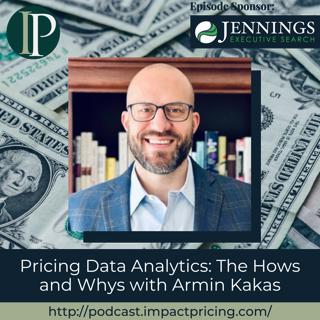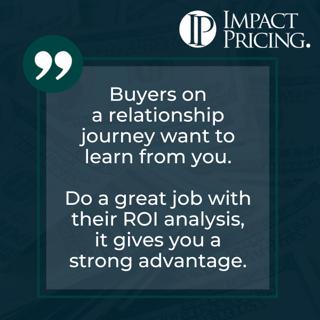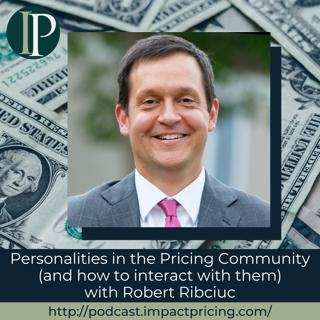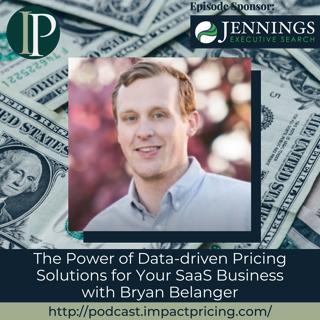
Pricing Table Topics: 9 of Diamonds – Buyers on a Trust Journey are Not Price Sensitive
This one is the 9 of Diamonds from the Selling Value card deck. Let's start with, what is a trust journey? A trust journey is when a buyer comes to you, you're the salesperson, a buyer comes to you and asks you for help figuring out what they need to buy, and they never go look at a competitive alternative. Your job, when they come talk to you, is to talk about, what's the value of solving the problem? What's the best solution to the problem? And importantly, you never ever mention a competitor. As far as your concerned competition doesn't even exist. When you can recognize that a buyer is going to buy from you without having looked at competitive alternatives, let me assure you, that buyer is not price sensitive. They're looking at, "Ooh, I've got to get this problem solved." They're not out spending their time trying to figure out, where do I get the best bang for the buck? That doesn't mean that we're going to gouge them, but it surely means that we don't have to give them deep discounts. How do you know if a buyer is on a trust journey or the relationship journey we talked about last week? The best question I've found to ask is, "If you don't buy this, what will you do?" We didn't imply there was competition. In fact, we implied there wasn't competition. And if they say, "Well, if I don't buy it, I'm going to go look at your competitor," then you know that competition is in the decision process. But if they say, "I don't know, or nothing," you know competition is not in the decision process. In which case they are not price sensitive. Don't give a big discount. We hope you enjoyed this example of Pricing Table Topics. What you just heard was done without a script. If you want to get better at speaking about pricing and value, grab a deck of our cards, pick a card, read the saying, then talk for one to two minutes about what that card says. You'll become a better speaker and expert. If you have any questions or feedback, please email me, mark@impactpricing.com. Now, go make an impact. Connect with Mark Stiving: Email: mark@impactpricing.com LinkedIn: https://www.linkedin.com/in/stiving/
15 Helmi 20232min

Pricing Data Analytics: The Hows and Whys with Armin Kakas
Armin Kakas is an expert in analytics, having lots of education in statistics, machine learning and A.I. He has an MBA, and he was a former VP of analytics at American Tire Distributors. He is also the founder of Revology Analytics, a revenue growth analytics consulting company. In this episode, Armin talks about data analytics and its crucial role in pricing and in businesses as a whole. Why you have to check out today's podcast: Learn the importance of gathering and understanding data both in B2B and B2C setups Find out why pricing and price adjustments must be base on data and customer feedback and should never be done internally in a company Learn how to communicate and unite insights from both the points of view of business people and statistics people "There needs to be a much smarter, much surgical way to manage discounts and really reward those customers that have the highest lifetime value or highest volume versus other things." – Armin Kakas Topics Covered: 01:55 – How Armin got into pricing 03:35 – B2B vs B2C: Armin's experience in applying pricing data analytics, and which one he prefers 05:57 – Armin's insights on B2C based on data 06:46 – What is promotional effectiveness 07:34 – Products Armin used to promote on Black Fridays when he worked at BestBuy 09:09 – Why CPGs must have a strong understanding of the relationship between price and value 10:19 – Why companies should asses price and value based on customers' response and not internally 13:08 – How businesspeople and statistics people shall communicate their insights with each other 18:41 – The most common problems Armin find when solving data problems for companies 20:06 – Why companies should have an "algorithm" that tells them how much to buy when a manufacturer offers big discounts 23:18 – Armin's pricing advice 25:28 – Connect with Armin Kakas Key Takeaways: "One of the easiest, quickest insights you can get is by figuring out which are the lowest ROI promotions that are not delivering any value for you or your customers or any of your channel partners, cut them, and reinvest it elsewhere in other growth areas of the company." – Armin Kakas "I think that price-value curve tends to change, especially in CPG quite often. And so, doing that more often is really, really beneficial for companies. And doing it in the right way." – Armin Kakas "All this unproductive inventory gathering dust in warehouses, clearance price optimization is a huge opportunity. Just really creating some automation and some dynamic methods to clear out the product that is tying up your capital and is actually lowering your productivity as well as your operating profit." – Armin Kakas "When you ask the question, "What are some of the other areas that make a huge impact for companies?", it is really things related to customer analytics, and that has two sides; One is providing insights… and then, the other side is providing actionable insights to the customers themselves." – Armin Kakas People / Resources Mentioned: Win Keep Grow: How to Price and Package to Accelerate Your Subscription Business – https://www.amazon.com/Win-Keep-Grow-Accelerate-Subscription/dp/1631954784 Impact Pricing: Your Blueprint for Driving Profits – https://www.amazon.com/Impact-Pricing-Blueprint-Driving-Profits/dp/1599184311 Connect with Armin Kakas: LinkedIn: https://www.linkedin.com/in/arminkakas/ Email: armin@revologyanalytics.com Website: https://www.revologyanalytics.com/ Connect with Mark Stiving: LinkedIn: https://www.linkedin.com/in/stiving/ Email: mailto:mark@impactpricing.com
13 Helmi 202326min

Blogcast: Pricing Trends in 2023
This is an Impact Pricing Blog published on January 4, 2023, turned into an audio podcast so you can listen on the go. Read Full Article Here: https://impactpricing.com/blog/pricing-trends-in-2023/ If you have any feedback, definitely send it. You can reach us at mark@impactpricing.com. Now, go make an impact. Connect with Mark Stiving: Email: mark@impactpricing.com LinkedIn: https://www.linkedin.com/in/stiving/
10 Helmi 20233min

Pricing Table Topics: 9 of Clubs – Buyers on a Relationship Journey want to Learn from You
This one is the 9 of Clubs from the Selling Value card deck. Let's start with, what is a relationship journey? Buyers who are on a relationship value journey realize they have a problem and then they go straight to a salesperson to learn. They didn't spend a whole bunch of time on the internet researching options or alternatives. They're the type of people who would rather learn from someone else, who would rather get the feedback. Let's say your refrigerator just broke down, and your friend says to you, "Hey, you got to go talk to Bob at the appliance store, Bob will help you out." And you walk in and start to talk to Bob. Now, what is Bob's job? Bob should be focused on, how is buying a new refrigerator going to be better for your life? Which style of refrigerator is going to be better for your life? They're truly focusing on the problem that you have and what's the best solution to your problem. They're not focused on saying, here's why my store is better than someone else's store, they're just focused on your problem. If you're in B2B sales, when you find someone who has been recommended to you, your job isn't to sell your product relative to a competitor. It's to sell, here's why solving that problem is so valuable to you. Now, the relationship journey implies that they're going to go on and talk to some of your competitors. The key though is when you have the chance to build the relationship to help your buyer understand the ROI, you've got this strong advantage because (a) they like you, (b) your competitor is probably not helping them with the ROI analysis, and you've demonstrated that you truly understand your buyer's problems. So, absolutely, when someone gets recommended to you or someone comes to you and they're not looking at competitive alternatives, talk about the value of solving the problem. Don't talk about competition. We hope you enjoyed this example of Pricing Table Topics. What you just heard was done without a script. If you want to get better at speaking about pricing and value, grab a deck of our cards, pick a card, read the saying, then talk for one to two minutes about what that card says. You'll become a better speaker and expert. If you have any questions or feedback, please email me, mark@impactpricing.com. Now, go make an impact. Connect with Mark Stiving: Email: mark@impactpricing.com LinkedIn: https://www.linkedin.com/in/stiving/
8 Helmi 20232min

Personalities in the Pricing Community (and how to interact with them) with Robert Ribciuc
For the last ten years, Robert Ribciuc has been working as the Managing Partner of EBITDA Catalyst, helping clients accelerate growth in key valuation metrics. He has a BA in Math and Economics from Harvard and an MBA from Chicago Booth School of Business. In this episode, Robert shares some of his insights on how to deal with different kinds of people in the industry, be it personal or online. Why you have to check out today's podcast: Get tips on how you could recover and avoid "falls" in your life Learn how to give feedback and criticisms in a nice, positive manner Discover some lesser-known tricks/hints about how the LinkedIn algorithm works "If enough people notice those behaviors in you, that are all about you – selfish, self-promoting, etc., most of the time, when a comment like that is posted, nobody replies or gives any acknowledgment to that kind of comment, and you can just hear in that wall of silence all the people who are mentally walking away from this person just like you described." – Robert Ribciuc Topics Covered: 01:37 – Pre-recording conversation about the pricing community and the different kind of people in the industry 07:10 – How to deal with people who self-aggrandize 11:46 – The recipe for avoiding the next "thud" in your life 17:06 – Why everyone avoids people who are negative, selfish, and self-promoting 20:42 – Why many people are reluctant to give feedback or criticism 23:24 – How to give feedback in a positive and helpful tone 24:31 – Some helpful LinkedIn tips/hints from Mark Stiving 29:04 – (When posting something) Add something positive to the conversation instead of demeaning the author 30:19 – Connect with Robert Ribciuc Key Takeaways: "Sometimes, pressure brings these behaviors that you and I may be chuckling at and promise ourselves we're not going to be like that." – Robert Ribciuc "If you remove this artificial constraint we placed on ourselves, like, 'I got to grow this fast' or 'I got to be on this trajectory' or 'I got to reach this amount of money' or whatever, and you just let that balancing act, and rest on what makes you feel most whole and contributing to the world, maybe that's a recipe for avoiding the next thud in your life." – Robert Ribciuc People / Resources Mentioned: Savvy Self-Promotion (HBR article): https://hbr.org/2021/05/savvy-self-promotion Unreasonable Hospitality: The remarkable Power of Giving People More Than They Expect: https://www.amazon.com/Unreasonable-Hospitality-Remarkable-Giving-People/dp/0593418573 Richard Bliss: https://www.linkedin.com/in/bliss Connect with Robert Ribciuc: LinkedIn: https://www.linkedin.com/in/ribciuc/ Email: robert@ebitdacatalyst.com Connect with Mark Stiving: LinkedIn: https://www.linkedin.com/in/stiving/ Email: mailto:mark@impactpricing.com
6 Helmi 202333min

Blogcast: A Nespresso Price Increase
This is an Impact Pricing Blog published on December 21, 2022, turned into an audio podcast so you can listen on the go. Read Full Article Here: https://impactpricing.com/blog/a-nespresso-price-increase/ If you have any feedback, definitely send it. You can reach us at mark@impactpricing.com. Now, go make an impact. Connect with Mark Stiving: Email: mark@impactpricing.com LinkedIn: https://www.linkedin.com/in/stiving/
3 Helmi 20232min

Pricing Table Topics: 9 of Hearts – The Most Common and Least Attractive Buyers
This one is the 9 of Hearts from the Selling Value card deck. It is true that buyers on an analytical journey are very price sensitive. Buyers on an analytical journey are probably the way you and I shop most of the time, and so it's the most common type of buyer's journey. These buyers are the ones who realize they have a problem, let's say, their refrigerator broke down. Then what do they do? They do a bunch of research to figure out what's the best refrigerator to replace the one that just broke. They know they need to go buy one, but they're on the internet looking at a whole bunch of different brands, maybe different technologies, styles, sizes, colors, and by the time they walk into a store, or two, or three, they've got a great feel and they're comparing, "Hey, how is this one better than that one?" These are really price sensitive buyers because they've identified what are all the different possibilities and they can trade off, "Oh, do I want water in the door, or ice in the door," and, "What's that extra cost going to be?" And, "Oh, this brand is so much better than that brand," and, "How much more am I willing to pay for it?" Price becomes a really big part of their purchase decision. Sadly, we have to deal with these, and we deal with these the way that they come and expect and ask questions, and we want to find an answer. But the real goal is to be able to identify the other types of buyer's journeys so that we have the ability to capture more revenue from them. We hope you enjoy this example of Pricing Table Topics. What you just heard was done without a script. If you want to get better at speaking and about pricing and value, grab a deck of our cards, pick a card, read the saying, and then talk for one to two minutes about what that card says. You'll become a better speaker and expert. If you have any questions or feedback, please email me, mark@impactpricing.com. Now, go make an impact. Connect with Mark Stiving: Email: mark@impactpricing.com LinkedIn: https://www.linkedin.com/in/stiving/
1 Helmi 20232min

The Power of Data-driven Pricing Solutions for Your SaaS Business with Bryan Belanger
Bryan Belanger is the senior director of Technology Business Research. He's also the senior director at XaaS Pricing, a subsidiary of TBR that helps SaaS companies price on a data-driven approach. In this episode, Bryan talks about the work that XaaS Pricing does and who their target customers are. He also shares his insights on other business and pricing models and how you could choose which one works best for your business. Why you have to check out today's podcast: Find out who XaaS Pricing are and how they might be able to help with your business Learn how to create a simple yet effective business framework by talking to your customers Get insights on the current trends such as usage-based pricing and product-led growth "Create a simple framework that works for you. For me, it's probably talk to ten customers; and that, I think, can help you. I think the hardest part is often knowing where to start or what you're even trying to solve for is. So, find a framework that works for you, that focuses on talking to your customers and asking these questions, and let it snowball from there." – Bryan Belanger Topics Covered: 01:51 – How Bryan got into pricing 02:56 – How XaaS started 03:40 – What XaaS Pricing actually does, and who their target customers are 05:00 – Why you'd want XaaS Pricing's products if you're a medium-sized company 09:41 – XaaS Pricing's vision: Systematize the Van Westendorp model 13:46 – Why people in B2B and SaaS businesses are not focusing at their competitors' prices 15:41 – How XaaS deals with pricing for new customers vs pricing for existing customers 17:34 – Bryan's thoughts on usage-based pricing 19:38 – Usage-based pricing works for some companies, but not for everyone 21:54 – Bryan's thoughts on product-led growth 25:17 – Does XaaS Pricing use the product-led growth business model? 26:17 – Bryan's pricing advice 27:32 – Connect with Bryan Belanger Key Takeaways: "I think there's a lot of great tools that if you know what to input, you can build, manage, measure, communicate economic value. But I think the gap is in actually finding the parts of the formula to input into those tools." – Bryan Belanger "Just building that muscle of talking to customers and understanding them. That's how I learned, it's just doing hundreds and hundreds of interviews and surveys. And I think the same applies within companies." – Bryan Belanger "I think the instances of true usage-based pricing are still edge cases, and most are just thinking about usage as a way to fence in package offerings more so than they are actually pricing based on usage." – Bryan Belanger "It's [product-led growth] not going to work for everybody... If it doesn't work for your customers, it really comes down to who you're targeting, what they value, how you engage with them, all those things. And so, I think like anything else, take it for the secular trend it is. Watch it, understand, learn, but don't jump in and try and change everything just because it's what worked for the people that it worked for." – Bryan Belanger People / Resources Mentioned: XaaS Pricing: https://www.xaaspricing.com/ OpenView: https://openviewpartners.com/ Peer Signal: https://peersignal.org/ Snowflake: https://www.snowflake.com/en/ Win Keep Grow: How to Price and Package to Accelerate Your Subscription Business: https://www.amazon.com/Win-Keep-Grow-Accelerate-Subscription/dp/1631954784 Connect with Bryan Belanger: LinkedIn: https://www.linkedin.com/in/bryan-belanger/ Connect with Mark Stiving: LinkedIn: https://www.linkedin.com/in/stiving/ Email: mailto:mark@impactpricing.com
30 Tammi 202329min






















